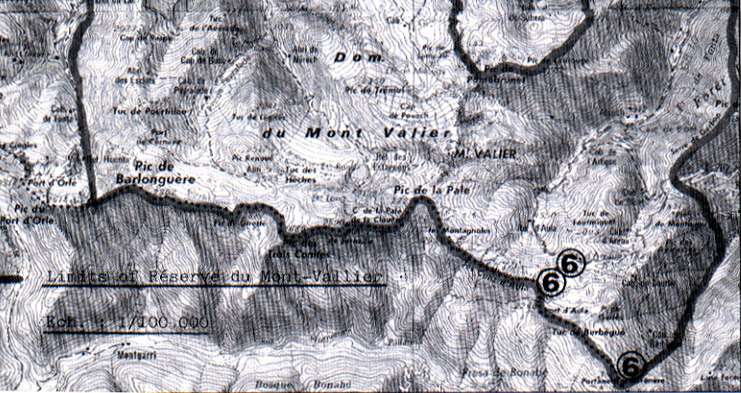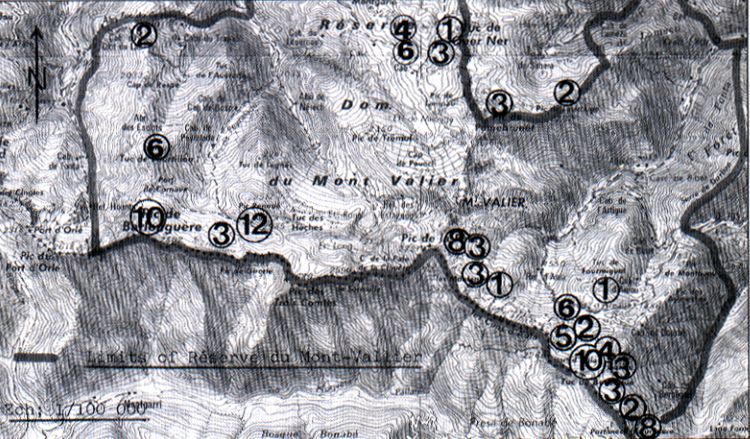Bassano B., Durio P., Gallo Orsi U., Macchi E
eds., 1992. Proceedings of the 1st Int. Symp. on
Alpine Marmot and genera Marmota. Torino.
Edition électronique, Ramousse R., International Marmot Network, Lyon 2002
THE INTRODUCTION OF THE MARMOT (Marmota marmota) INTO THE MONT VALLIER NATURE RESERVE, AND THE HISTORY OF ITS SUBSEQUENT COLONISATION BETWEEN 1961 AND 1991
Nebel D. and Franc R.
Technical Group of the Mont-Vallier Nature Reserve, French Forestry Commission Office National des Forêts (19140 SEIX)
Abstract - The Mont-Vallier Reserve is situated in the Ariège region of the Pyrenees, adjacent to the Spanish border; its surface area is 9 000 Ha, and the altitude range is 900-2800m. The marmot was net found formerly in this part of the Central Pyrenees. From 1961 to 1972, 18 marmots from the French Alps were introduced in the Reserve, in three sites located near the international ridge.
The introduced marmots dispersed into the Spanish (south) side of the ridge soon after introduction and successfully reproduced there. By 1967, some of the Spanish marmots had recolonized the slopes on the French side. Some individuals were captured from the French colonies, for introductions further west on the Reserve (towards the Barlonguere).
Marmots established territories amongst fallen rocks and boulders, and surrounding areas of grass. On the Reserve, adequate territory sites are found at the base of cliffs, between 1500 and 2300m, but at present only area of fallen rocks above 1900m are used by the species. In the last 10 years, there has been a demographic explosion leading to the colonization of all suitable habitat. There are currently 15 colonies of marmots on the French slopes. The Reserve is now host to more than 100 of these charming rodents.
PRESENTATION
The Mont-Vallier Nature Reserve is in the Central Pyrenees, in the Department of Ariège. Its Southern limit is the frontier with Spain. It is 9000 hectares in area, and rises from 900 to 2800 metres in altitude. The marmot was not found originally in the Pyrenees mountain chain. It was between 1961 and 1972 that 18 marmots from the French Alps were introduced into the Reserve along the frontier ridge, at three different points (see map 1).
AREAS OF INTRODUCTION
a) Area around Port d'Aula.
In August 1961, six marmots from the Vanoise region were introduced into the screes below the Port d'Aula, at 2200 metres altitude. To encourage the establishment of a marmot colony, artificial burrows were prepared (trenches 20 x 20 cm in cross - section, two metres in length, covered with flat stones earth). This nucleus became well established, for in 1965 twenty-five marmots were living in this area. From 1965 onwards, however, a pastoral road opened as far as the frontier with Spain seriously disturbed the new colony (using part of the scree colonised by the marmots, and causing a great influx of visitors), which emigrated to the Spanish side of the frontier, to take up residence near the Port d'Aula, and subsequently to reproduce form four colonies between Aula and Pic de la Pale, before returning to colonise the French side of the frontier from 1980 onwards. The closure of this road to the public in 1986 had a very favourable impact on the marmot population. Three news colonies have been formed below the Port d'Aula, near the road, between 1986 and 1991.
b) Area around Portanech d'Aurenert.
In 1965 six marmots from the Vanoise region were introduced along the Eastern edge of the Reserve. This new nucleus established itself well at first, for in 1975 twenty animals were observed. Then the population decreased to 10 in 1991. This decrease was probably caused by disturbances from hunting activities, since the burrows are located at the edge of the Reserve in an area where hunting takes place.
c) Area around Bouches d'Aula.
Finally, in 1972, six marmots from Queyras were released near the Bouches d'Aula, beneath the Port d'Aula. These have not remained in place, but have mixed with the colonies already in existence around Aula and in Spain.
d) Other introductions.
Using animals from the Port d'Aula colonies, in 1970 marmots were introduced in other areas: - five marmots to the North of Milouga lakes - four marmots near the Etang Long lake.
LOCATION AND EVOLUTION OF THE COLONIES
The marmots use the areas of boulders and scree made up of schist and calschist, as well as the nearby grass slopes. The animals prefer sites with Southern (South-East to South-West) exposition. At the moment there are twenty-five colonies of marmots in the Reserve, whereby only screes at altitudes greater than 1900 metres are in use. It is only in the last ten years that we being progressively colonised. In 1991, the population of marmots, and all the well-situated screes we being progressively colonised. In 1991, the population in the Reserve is of the order of hundred marmots (Map 2).
STUDY PROJECTS
The following study projects are planned:
- marking of marmots to follow the progress of colonisation
- a study of the evolution of the present colonies, number of animal and reproduction
- capture of marmots and their introduction into the western part of the Reserve, in the Orle valley, in order to study the progress of new colonies.
L'INTRODUZIONE DELLA MARMOTTA (Marmota marmota) NELLA RISERVA NATURALE Dl MONT-VALLIER E LA STORLA DELLA SUA SUCCESSIVA COLONIZZAZIONE TRA IL 1961ED IL 1991
Nebel D. e Franc R.
Technical Group of the Mont-Vallier Nature Reserve, French Forestry Commission Office National des Foret (19140 SEIX)
Â
Presentazione
La Riserva Naturale di Mont-Vallier é situata nei Pirenei Centrali, nel Dipartimento di Ariège. Il suo limite meridionale é rappresentato dal confine con la Spagna. Ha un'estensione di 9000 ha e l'altitudine varia dai 900 ai 2800 metri.
La Marmotta non si trovava originariamente sulla catena dei Pirenei.Tra il 1961 ed il 1972 18 marmotte provenienti dalle alpi francesi furono introdotte in tre siti lungo lo spartiacque della riserva (carta 1).
Aree di introduzione
a ) D in torni di Port d'Aula.
Nell'agosto del 1961 sei marmotte della regione della Vanoise furono introdotte su pendii rocciosi a valle di Port d'Aula a 2200 metri di quota. Per incoraggiare l'insediamento di una colonia di marmotte furono preparate delle cavità artificiali (scavi di 20 cm di diametro per due metri di lunghezza coperti di pietre piatte e terra). Questo nucleo prosperô tanto che, nel 1965, 25 marmotte vivevano in quell'area. Nel 1965 venne aperta lungo la frontiera spagnola una strada per i pastori che reco notevole disturbo alla colonia (in quanto attraversava parte della pietraia colonizzata e determinô l'arrivo di numerosi visitatori). Le marmotte si spostarono sul lato spagnolo della frontiera e si insediarono vicino a Port d'Aula dove si riprodussero e formarono 4 nuove colonie tra Aula e Pic de la Pale per poi ritornare a colonizzare il versante francese nel 1980. La chiusura al pubblico di questa strada dal 1986 ha avuto un influsso molto positivo sulla popolazione di marmotte. Tra il 1986 e il 1991 si.sono formate tre nuove colonie sotto Port d'Aula vicino alla strada.
b) Dintorni di Portanech d'Aurenert.
Nel 1965 furono introdotte 6 marmotte della regione della Vanoise nella parte orientale della Riserva. Il nuovo nucleo si riprodusse bene fin dall'inizio tanto che nel 1975 furono osservati 20 animali.
La popolazione poi si ridusse a 10 nel 1991. Questa diminuzione é stata probabilmente causata dalla caccia in quanta le tane sono localizzate ai margini della Riserva in un'area dove viene praticata l'attività venatoria.
c) Dintorni di Bouches d'Aula
Nel 1972 sei marmotte provenienti dal Queyras furono liberate vicino alle Bouches d'Aula, sotto Port d'Aula.
Queste non si sono stabilite in loco, ma sono confluite nelle colonie già esistenti attorno ad Aula ed in Spagna.
d) Altre introduzioni
Utilizzando animali delle colonie di Port d'Aula, nel 1970 le marmotte furono introdotte in altre aree: - cinque marmotte a nord dei laghi Milouga - quattro marmotte vicini al lago Etang Long
Localizzazione ed evoluzione delle colonie
Le marmotte utilizzano le aree con massi e detriti rocciosi di scisti e calcescisti e le circostanti distese erbose. Gli animali preferiscono siti con esposizioni meridionali (da Sud-Est a Sud-Ovest). Al momento attuale vi sono 25 colonie nella Riserva dove vengono utilizzate solo pietraie al di sopra dei 1900 metri.
La colonizzazione ha avuto inizio dieci anni fa. Nel 1991 la popolazione di marmotte sta progressivamente colonizzando tutte le pietraie adatte. La popolazione attuale é nell'ordine del centinaio di animali (carta 2).
Progetto di studio
Sono stati programmati i seguenti studi:
- marcatura di marmotte perseguire la colonizzazione
- dimensioni e tassi riproduttivi delle colonie esistenti
- cattura di animali e fora introduzione nella parte occidentale della Riserva, nella Valle di Orle, al fine di studiare la sviluppo di nuove colonie.
Â
Â
Map 1. Spread of colonics betwccn 1961 and 1991 INITIALLY
6 Introduction points. For cach zone of release 3 females and 3 males.

ritorno/back
Map 2. Spread of colonies between 1961 and 1991 INITIALLY
2 Location of colonies, and presenit numbcrs of mamots

ritorno/back
Tornare index / back contents
Â
